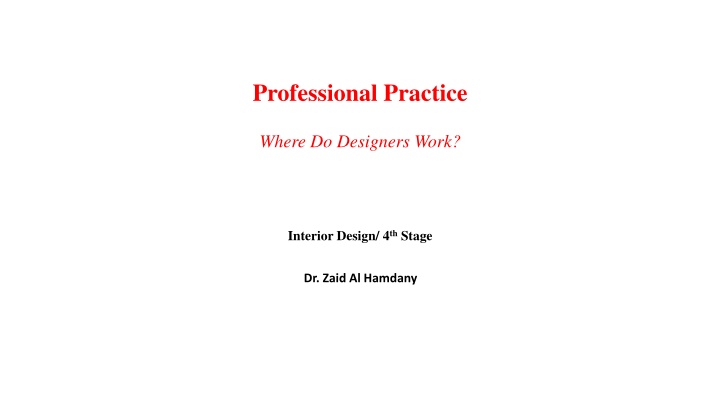Professional Practice
Interior design offers various career paths such as residential and commercial design, selling responsibilities, freelance consulting, and working on the boards. Designers can choose roles based on their creative or technical strengths, each requiring different skill sets and levels of client interaction.
Download Presentation

Please find below an Image/Link to download the presentation.
The content on the website is provided AS IS for your information and personal use only. It may not be sold, licensed, or shared on other websites without obtaining consent from the author.If you encounter any issues during the download, it is possible that the publisher has removed the file from their server.
You are allowed to download the files provided on this website for personal or commercial use, subject to the condition that they are used lawfully. All files are the property of their respective owners.
The content on the website is provided AS IS for your information and personal use only. It may not be sold, licensed, or shared on other websites without obtaining consent from the author.
E N D
Presentation Transcript
Professional Practice Where Do Designers Work? Interior Design/ 4thStage Dr. Zaid Al Hamdany
One of the fascinating aspects of the interior design profession is the variety of ways in which an individual can work in the field. Although many designers engage in residential design, working in a commercial specialty is attractive for many others. It is also fairly common for some designers to occasionally be switch hitters, designing both residences and commercial spaces. Interior designers also work in different ways. That is, some are fully involved with clients and a project from programming through contract documents. Some prefer the technical side of design rather than working directly with clients. And there are those who enjoy client interaction so much that they move from performing space-planning tasks to selling and representation positions with stores or even manufacturers.
HOW DO DESIGNERS WORK? There are many different ways to work in the interior design field. Some of these will appeal to your creative side and some to technical prowess. These descriptions begin our clarification of the wide variety of career opportunities in the interior design profession. The following is a basic description of the ways designers work. On-the-Boards Responsibility The term on the boards is an old one used by many interior designers to refer to the traditional tasks of doing a project. Being on the boards means that the designer spends a significant amount of time preparing space plans, construction drawings, and other design documents utilizing a drafting board. Of course, today the on-the-boards designer is working with a computer rather than paper-and-pencil drawing and drafting.
Selling Responsibility Many positions in interior design require a certain amount of selling responsibility. In fact, it might be argued that all positions require the ability to sell. Selling responsibility starts with the job interview with an employer. Designers must then sell themselves to prospective clients as they attempt to be hired by the client. Selling also occurs as designers sell their design ideas to the client as the project progresses. Selling responsibility positions are usually compensated by a commission on each sale rather than a salary. A salary is a fixed payment per hour, week, or month, whereas a commission is a flexible amount based in some way on the amount and dollar value of products sold.
Freelance Consulting Designers who have gained experience in interior design may decide to become freelance designers/consultants. It could be argued that a sole practitioner designer is a freelance designer. For our purposes, however, this discussion refers to designers who work irregular hours, not necessarily full time, and not directly for end-user clients such as a home owner or commercial space owner. This type of freelance consultant enjoys variety and does not want to work full time. The Internet allows freelancers to work on a global basis if they so choose. It is unusual for the freelance consultant to have employees. Drawbacks include an irregular income, as work comes at an unsteady pace. These individuals must also pay their own working benefits, taxes on income, and have the self-discipline to work to the extent required for each consulting job.
Management Interior designers also work as managers in design industry businesses. An individual might be the design director with an interior design or architectural office, supervising a design staff. She/he might be the manager of the design staff in a furniture store, or the manager of a specialty store. She/he might have a management position as a project manager for a construction company or development company. These are only a few examples of management positions. The person who is considering management positions in interior design will be required to have extensive experience in one or more specialty areas of interior design. A business background based on experience in the profession, along with educational background in management, is also helpful if not required for these positions.
GLOBAL DESIGN WORK Interior design is certainly a global profession. Computers and the Internet have expanded the reach of designers throughout the world. Virtual communications make it easy to hold meetings, transmit drawings and other documents, and manage projects on a global market net. In some cases, firms enter into joint ventures to design international projects. Larger firms and existing international firms continue to obtain international projects. Ease of communication based on language skills is a paramount issue. International design work requires staff members to have (or quickly acquire) applicable language skills. Being able to communicate in one or more languages gives a firm engaging in global design a definite advantage. However, language skills are only part of the challenge; an understanding of cultural differences and customs is also critical.
TYPES OF WORK ENVIRONMENTS Interior designers can work in so many settings and do so many different kinds of jobs. Independent Design Firm An independent design firm is one that has no affiliation with a particular product and may not have any products displayed for sale in its office or studio. It is very common for interior designers to start their businesses working alone with no full-time employees; these would be considered independent interior design firms. Some, however, have a limited amount of showroom space. It is common for many independent design firms to sell merchandise to supplement revenue, in addition to providing design services. Because such a firm is independent, it may specify any products that are available in the marketplace.
The firm may specialize in some type of interior or design a combination of types of spaces. The projects obtained by independent design firms frequently require that the designer travel extensively, as the firm s work comes from all over the country, if not the world. This is especially true for the very specialized firm. Design employees are paid a salary and possibly a commission or bonus for product sales. An independent design firm may be a one-person design studio or a large firm that has dozens of employees. Residential Furniture Stores Entry-level designers who begin their careers in a residential retail furniture store generally do so as an assistant to one of the senior designers. Assistants learn the business and gain experience with clients as they help senior designers with product specifications, drafting, sample boards, and specifications, along with many other activities. Direct client interaction occurs as the assistant gains experience and confidence.
The experienced designer works with the client in either the store or the clients home. Projects might involve designing a single space or designing and specifying items for an entire home. The designer is encouraged to sell what the store carries in inventory, but may be allowed to sell other items as well. Most often, the design service is free or offered at nominal cost, because the expense of the designer s service is covered through the sale of goods at retail. Designers are often required to meet sales quotas and most often are paid on a commission basis rather than a salary. Entry-level individuals are more often paid a salary, though they might receive a small commission. Depending on the store s management philosophy, it might take an entry-level person from two to four years to be promoted out of the assistant s position.
Office Furnishings Dealer An office furnishings dealer is, in a sense, a retail showroom for commercial furniture products. Office furnishings dealers primarily design office complexes, though some also design other kinds of commercial interiors. They will have showroom displays and an inventory to back up what is displayed. Many office furnishings dealers have certain exclusive products that they expect designers to specify most often. Office furnishings dealerships can provide excellent entry-level opportunities for those interested in commercial interior design. It often takes at least two years to advance to a position of project responsibility. The pay is usually a salary for the designers, who might also be eligible for commission on certain items.
Retail Specialty Store A specialty store is a retail store selling a particular type of product other than furniture to the end user. Design services, if offered, are complimentary. Specialty stores are excellent opportunities for the entry-level designer to gain sales experience and product knowledge. Depending on the product, the staff will receive training related to the products. However, some specialty stores, such as art galleries or antique stores, may require staff to have specialized knowledge prior to hiring. Designers are commonly paid a small salary plus a commission.
Architectural Office Many architectural offices have interior design divisions, providing yet another setting for the interior designer. These designers work primarily on projects in partnership with the architects as part of a design team. The work might involve residential or commercial projects, or both, depending on the nature of the architectural practice. Interior design employees in this setting will be required to have very good space-planning and technical skills, design creativity, and skill with the production of construction drawings and documents; the use of CAD is critical in this practice setting. Compensation is salary based.
Department Store Department stores often have interior design staff. The size and complexity of the design studio will depend on the size of the store. Working for a department store is very similar to working for a retail furniture store. A designer might sell one item or a range of products. Often, however, the designer is limited to selling what the department store carries. Department stores may also have a studio that focuses on commercial projects, in addition to residential. Some department stores offer a limited range of design services through the drapery or floorings departments. There may also be an opportunity to become a furniture sales associate whose primary responsibility is selling rather than design. Generally, design services are offered free to the client.
Manufacturer Companies that manufacture furniture, furnishings, and equipment (FF&E) products use interior designers in many ways. A designer might work in a manufacturer s showrooms, assisting the interior designers and other allied professionals who come to the showroom. A few manufacturers have staff designers at a factory location to aid other designers and architects in planning and specifying the company s products. Corporations Many large corporations have in-house interior designers or facility planners. Corporate designers might be in charge of the complete design process for departments and facilities, or might work with outside designers in the design of corporate facilities.
Universities and Colleges Most universities, colleges, and community colleges have a facilities planning office. This office works with outside architects, interior designers, and the school staff to develop new building designs and remodel existing structures. A few of the largest universities retain design staff as employees. Educational design work is challenging, because most projects must be designed as economically as possible while still providing interesting and functional environments. Compensation is by salary and the employee benefits are also very good.
Expectations As an employee, you are no doubt looking for opportunities that will challenge you to use the design education you have recently completed. Truthfully, your new bosses probably want to challenge you and get the best possible work out of their new employee investment but they will not quite be ready to give you the keys to the Mercedes. That simply means although you showed them enough skills, knowledge, and enthusiasm to be hired to work at ABC Design Studio, they are not ready to let you loose on clients or major projects.
Your boss will be assigning you work responsibilities that might even seem beneath your skill level. Just about everybody who has graduated from an intense interior design program has thought to themselves in those first weeks, I didn t go to school to file price lists and brochures or clean up sample books! There is actually method to this task: it is an excellent way for the novice to learn sources . . . and filing these things keeps the studio looking organized. While projects are being processed, interior design work in most studios and offices is intensely busy. The owner and senior designers are pushing to prepare whatever design documents are needed for the projects on the schedule board. Often decisions on specifications for the wide range of products used in a residential or commercial project have to be made quickly.
It is perfectly reasonable for you to expect that the boss or senior designers will spend time training you in the way the office does projects. However, because of the speed at which design work must be done, sometimes those experienced individuals don t give much thought to their training responsibilities. You need to ask questions, ask to be involved, ask how you can help. Each office has its own particular way of doing things. Many novice designers have found out that those ways are different from how they were taught. It s not that you were taught the wrong information or wrong skills. It s just that practicing designers learn shortcuts or techniques that are difficult to incorporate into an educational program.
In a short statement: As an entry-level interior designer, it is important to understand that job opportunities will not be available to you unless you have the skills and knowledge gained in an academic program. Nevertheless, you still have a lot to learn about doing projects, professionalism, and meeting responsibilities related to working directly with clients. Although you may be impatient to be given responsibility for designing a project, it is important for you to understand that the time spent in learning on the job is necessary to help prevent you from making mistakes that can hurt both your short-term and your long-term career.























